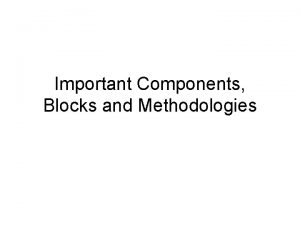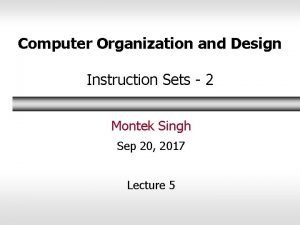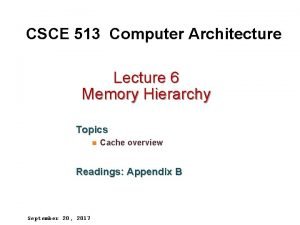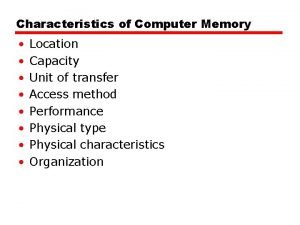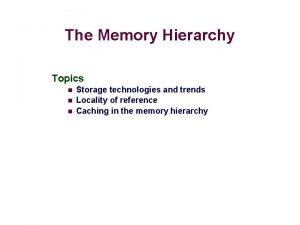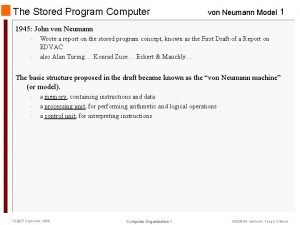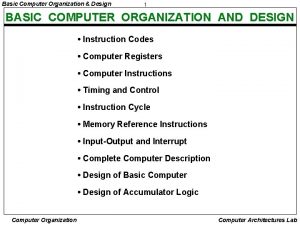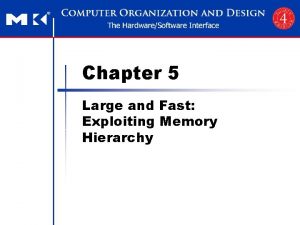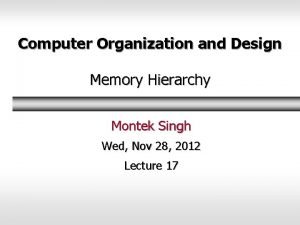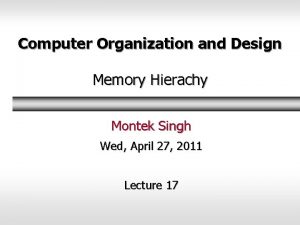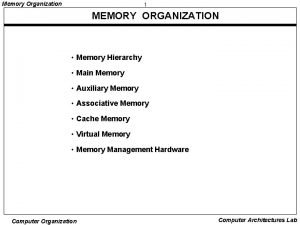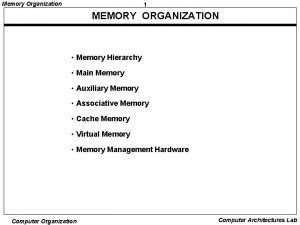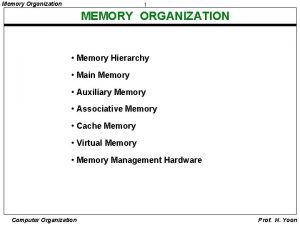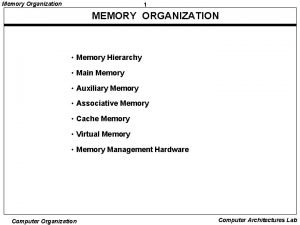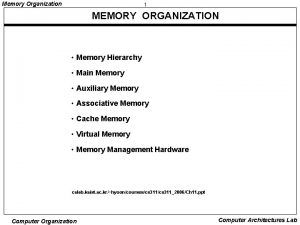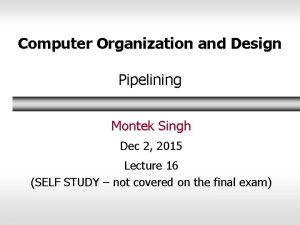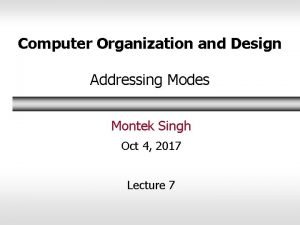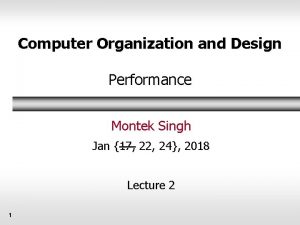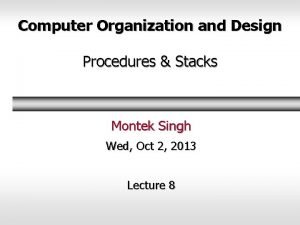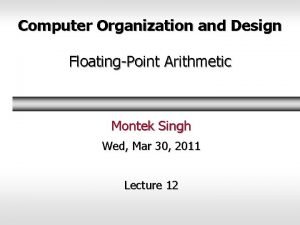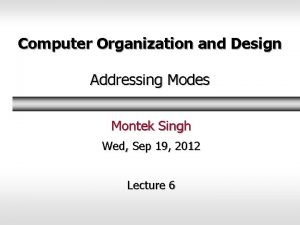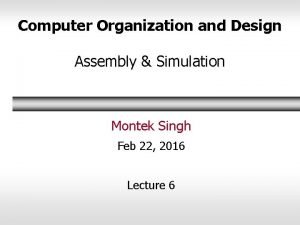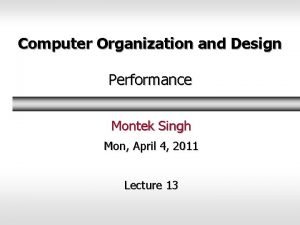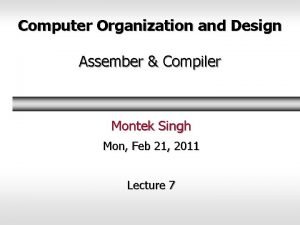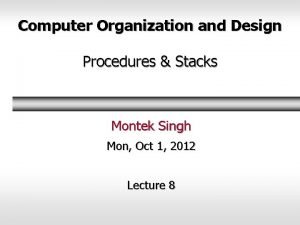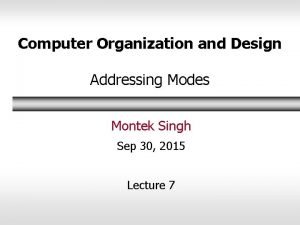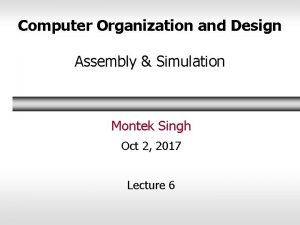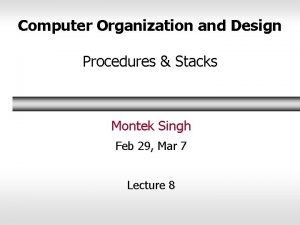Computer Organization and Design Memory Hierarchy Montek Singh























- Slides: 23

Computer Organization and Design Memory Hierarchy Montek Singh Nov 30, 2015 Lecture 15

Topics ã Memory Flavors ã Principle of Locality ã Memory Hierarchy: Caches ã Associativity ã Reading: Ch. 5. 1 -5. 3

What Do We Want in a Memory? PC ADDR INST DOUT mini. MIPS MADDR MDATA Wr MEMORY ADDR DATA R/W Capacity Latency Cost 1000 s of bits 10 ps $$$$ SRAM 1 -8 MBytes 0. 5 -1 ns $2 K/GB DRAM 1 -8 GBytes 50 ns $20/GB 100 s GBytes 10 ms 20¢/GB Huge Low (fast) Cheap! Register Hard disk* Want? *non-volatile: Typically magnetic disk drive, but also SSD/flash now

Best of Both Worlds ã What we REALLY want: A BIG, FAST memory! l Keep everything within instant access ã We’d like to have a memory system that l Stores 2 -16 GB of data like DRAM would Ø typical SRAM sizes are in MB, not GB l Performs fast like SRAM would Ø typical DRAMs are order of magnitude slower than SRAM l SURPRISE: We can (nearly) get our wish! Ø Key Idea: Use a hierarchy of memory technologies: SRAM CPU MAIN MEM (DRAM) DISK

Principle of Locality ã Key Idea: Exploit “Principle of Locality” l Keep data used often in a small fast SRAM Ø called “CACHE”, often on the same chip as the CPU l Keep all data in a bigger but slower DRAM Ø called “main memory”, usually separate chip l Access Main Memory only rarely, for remaining data l The reason this strategy works: LOCALITY Ø if you access something now, you will likely access it again (or its neighbors) soon Locality of Reference: Reference to location X at time t implies that reference to location X+ X at time t+ t is likely for small X and t. Put simply: If a location is accessed in memory, the same location or its neighbors will likely be accessed soon.

Typical Memory Reference Patterns ã Memory Trace l A temporal sequence of memory references (addresses) from a real program. address stack ã Temporal Locality l If an item is referenced, it will tend to be referenced again soon data ã Spatial Locality l If an item is referenced, nearby items will tend to be referenced soon. program time

Cache ã cache (kash) n. l A hiding place used especially for storing provisions. l A place for concealment and safekeeping, as of valuables. l The store of goods or valuables concealed in a hiding place. l ã Computer Science. A fast storage buffer in the central processing unit of a computer. In this sense, also called cache memory. v. tr. cached, cach·ing, cach·es. l To hide or store in a cache.

Cache Analogy ã You are writing a term paper for your history class at a table in the library l As you work you realize you need a book l You stop writing, fetch the reference, continue writing l You don’t immediately return the book, maybe you’ll need it again l Soon you have a few books at your table, and you can work smoothly without needing to fetch more books from the shelves l The table is a CACHE for the rest of the library ã Now you switch to doing your biology homework l You need to fetch your biology textbook from the shelf l If your table is full, you need to return one of the history books back to the shelf to make room for the biology book

Exploiting the Memory Hierarchy ã Memory Hierarchy is hidden from programmer! l Programming model: SINGLE kind of memory, single address space. l Transparent to programmer: Machine AUTOMATICALLY assigns locations, depending on runtime usage patterns. Ø programmer doesn’t (cannot) know where the data is actually stored! CPU Small SRAM “CACHE” Dynamic RAM “MAIN MEMORY” HARD DISK

Exploiting the Memory Hierarchy ã CPU speed is dominated by memory performance l More significant than: ISA, circuit optimization, pipelining, etc. CPU Small SRAM Dynamic RAM “CACHE” “MAIN MEMORY” HARD DISK “VIRTUAL MEMORY” “SWAP SPACE” l TRICK #1: Make slow MAIN MEMORY appear faster Ø Technique: CACHING l TRICK #2: Make small MAIN MEMORY appear bigger Ø Technique: VIRTUAL MEMORY

The Cache Idea Program-Transparent Memory Hierarchy: l Cache contains TEMPORARY COPIES of selected main memory locations… Ø e. g. Mem[100] = 37 (1. 0 - ) 1. 0 CPU 100 ã Two Goals: 37 Cache l Improve the average memory access time Ø HIT RATIO ( ): Fraction of refs found in cache Ø MISS RATIO (1 - ): Remaining references Ø avg total access time depends on these parameters l Transparency (compatibility, programming ease) DYNAMIC RAM Main Memory Challenge: To make the hit ratio as high as possible.

How High of a Hit Ratio? ã Suppose we can easily build an on-chip SRAM with a 0. 8 ns access time, but the fastest DRAM we can buy for main memory has access time of 10 ns. How high of a hit rate do we need to sustain an average total access time of 1 ns? Wow, a cache really needs to be good!

Cache ã Sits between CPU and main memory ã Basically a fast table that stores a TAG and DATA l TAG is the memory address Main Memory l DATA is a copy of memory contents at the address given by TAG Tag Data 1000 17 1004 23 1008 11 1000 17 1012 5 1040 1 1016 29 1032 97 1020 38 1008 11 1024 44 Cache 1028 99 1032 97 1036 25 1040 1 1044 4

Cache Access ã On load (lw) we look in the TAG entries for the address we’re loading l Found a HIT, return the DATA l Not Found a MISS, go to memory for the data and put it and the address (TAG) in the cache Tag Data Main Memory 1000 17 1004 23 1008 11 1000 17 1012 5 1040 1 1016 29 1032 97 1020 38 1008 11 1024 44 Cache 1028 99 1032 97 1036 25 1040 1 1044 4

Cache Lines ã Usually get more data than requested l a LINE is the unit of memory stored in the cache l usually much bigger than 1 word, 32 bytes per line is common l bigger LINE means fewer misses because of spatial locality l but bigger LINE means longer time on miss Main Memory 1000 17 1004 23 1008 11 1012 5 Tag Data 1016 29 1020 38 1000 17 23 1040 1 4 1032 97 25 1032 97 1008 11 5 1036 25 Cache 1024 44 1028 99 1040 1 1044 4

Finding the TAG in the Cache ã Fully Associative: l Requested data could be anywhere in the cache l Fully Associative cache uses hardware to compare the address to the tags in parallel but it is expensive Ø 1 MB is thus unlikely, typically smaller ã Direct Mapped Cache: l Directly computes the cache entry from the address Ø multiple addresses will map to the same cache line Ø use TAG to determine if right l Choose some bits from the address to determine cache entry Ø low 5 bits determine which byte within the line of 32 bytes Ø we need 15 bits to determine which of the 32 k different lines has the data Ø which of the 32 – 5 = 27 remaining bits should we use?

Direct-Mapping Example ã Suppose: 2 words/line, 4 lines, bytes are being read l With 8 byte lines, bottom 3 bits determine byte within line l With 4 cache lines, next 2 bits determine which line to use Ø 1024 d = 100000 b line = 00 b = 0 d Main memory Ø 1000 d = 01111101000 b line = 01 b = 1 d 1000 17 Ø 1040 d = 10000010000 b line = 10 b = 2 d 1004 23 1008 11 1012 5 Tag Data 1024 44 99 1000 17 23 1040 1 4 1016 29 38 Cache 1016 29 1020 38 1024 44 1028 99 1032 97 1036 25 1040 1 1044 4

Direct Mapping Miss ã What happens when we now ask for address 1008? Ø 1008 d = 01111110000 b line = 10 b = 2 d l …but earlier we put 1040 d there Ø 1040 d = 10000010000 b line = 10 b = 2 d l …so evict 1040 d, put 1008 d in that entry Tag Data Memory 1000 17 1004 23 1008 11 1012 5 1016 29 1024 44 99 1000 17 23 1024 44 1008 1040 11 1 5 4 1028 99 1016 29 38 1032 97 1020 38 1036 25 Cache 1040 1 1044 4

Miss Penalty and Rate ã How much time do you lose on a Miss? l MISS PENALTY is the time it takes to read the main memory if data was not found in the cache Ø 50 to 100 clock cycles is common l MISS RATE is the fraction of accesses which MISS l HIT RATE is the fraction of accesses which HIT l MISS RATE + HIT RATE = 1 ã Example l Suppose a particular cache has a MISS PENALTY of 100 cycles and a HIT RATE of 95%. The CPI for load on HIT is 5 but on a MISS it is 105. What is the average CPI for load? Ø Average CPI = 5 * 0. 95 + 105 * 0. 05 = 10 l What if MISS PENALTY = 120 cycles? Ø Average CPI = 5 * 0. 95 + 120 * 0. 05 = 11

Continuum of Associativity Fully associative address Compares addr with ALL tags simultaneously location A can be stored in any cache line. N-way set associative address Direct-mapped address N Compares addr with N tags simultaneously. Data can be stored in any of the N cache lines belonging to a “set” like N direct-mapped caches. Compare addr with only ONE tag. Location A can be stored in exactly one cache line. What happens on a MISS? Finds one entry out of entire cache to evict Finds one entry out of N in a particular row to evict There is only one place it can go

Three Replacement Strategies ã When an entry has to be evicted, how to pick the victim? l LRU (Least-recently used) Ø replaces the item that has gone UNACCESSED the LONGEST Ø favors the most recently accessed data l FIFO/LRR (first-in, first-out/least-recently replaced) Ø replaces the OLDEST item in cache Ø favors recently loaded items over older STALE items l Random Ø replace some item at RANDOM Ø no favoritism – uniform distribution Ø no “pathological” reference streams causing worst-case results Ø use pseudo-random generator to get reproducible behavior

Handling WRITES ã Observation: Most (80+%) of memory accesses are reads, but writes are essential. How should we handle writes? l Two different policies: Ø WRITE-THROUGH: CPU writes are cached, but also written to main memory (stalling the CPU until write is completed). Memory always holds the latest values. Ø WRITE-BACK: CPU writes are cached, but not immediately written to main memory. Main memory contents can become “stale”. Only when a value has to be evicted from the cache, and only if it had been modified (i. e. , is “dirty”), only then it is written to main memory. l Pros and Cons? Ø WRITE-BACK typically has higher performance Ø WRITE-THROUGH typically causes fewer consistency problems

Memory Hierarchy Summary ã Give the illusion of fast, big memory l small fast cache makes the entire memory appear fast l large main memory provides ample storage l even larger hard drive provides huge virtual memory (TB) ã Various design decisions affect caching l total cache size, line size, replacement strategy, write policy ã Performance l Put your money on bigger caches, then bigger main memory. l Don’t put your money on CPU clock speed (GHz) because memory is usually the culprit!
 Raj birk
Raj birk Virtual memory in memory hierarchy consists of
Virtual memory in memory hierarchy consists of Arti montek
Arti montek Montek fawk
Montek fawk Montek x-1000
Montek x-1000 Computer architecture
Computer architecture Computer memory hierarchy
Computer memory hierarchy Computer memory hierarchy diagram
Computer memory hierarchy diagram Computer memory hierarchy diagram
Computer memory hierarchy diagram Memory hierarchy in computer
Memory hierarchy in computer Modello von neumann
Modello von neumann Memory organisation in computer architecture
Memory organisation in computer architecture Process organization in computer organization
Process organization in computer organization Computer architecture and computer organization difference
Computer architecture and computer organization difference Basic computer design
Basic computer design 2140707
2140707 Design of basic computer with flowchart
Design of basic computer with flowchart Basic computer design
Basic computer design Structure of computers
Structure of computers Large and fast: exploiting memory hierarchy
Large and fast: exploiting memory hierarchy Memory system design in computer architecture
Memory system design in computer architecture Internal memory and external memory
Internal memory and external memory Primary memory and secondary memory
Primary memory and secondary memory Virtual memory
Virtual memory



